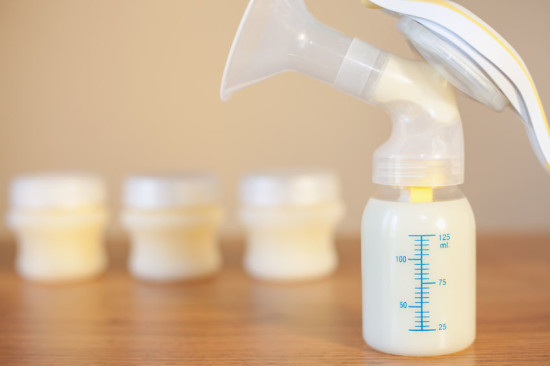
Copyright: petunyia / 123RF Stock Photo
BREASTFEEDING is more complicated than many think. It is not as easy as just helping baby to latch on correctly or merely expressing milk. There are many questions that mothers have about the milk, storing it and daily challenges.
While you can seek answers from your doctor or a lactation consultant, you can also go to SusuIbu.com which seeks to educate and offer help to nursing mothers.
Director Nor Kamariah Mohamad Alwi says her initial purpose in setting up SusuIbu.com was to help other mothers.
“I felt like I was alone in breastfeeding. I had no problems but some of my friends did. At that time Internet usage was just booming in Malaysia, so I set up a website with a forum. The growth was very organic.
“The questions slowly became more challenging and I knew that my experience as a mother was not enough. Even though it was set up as a forum for discussion, as the administrator and moderator, I felt responsible to provide the ultimate answer. I realised I had to learn more about breastfeeding and couldn’t just rely on my own experience. That’s when I got to know some of the local experts and became an International Board Certified Lactation Consultant,” she says.
In 2004, SusuIbu.com was founded as a home-based service. It first opened its doors in Bangi in 2007. In 2008, breastfeeding consultant Rita Rahayu started her outlet Mom’s Little Ones in Seri Kembangan. And, in 2009, the two entities merged to become SusuIbu/Mom’s Little Ones.
Nor Kamariah answers some common questions that mothers have:
How much milk should I have?
Generally, babies aged one to six months around the world consume around 600ml-900ml in 24 hours. For those younger than one month, it is less than that. The baby’s milk intake stabilises by one month old. There may be a few minor cases who may drink less or more than that. It has been found that once baby sets the limit to how much he or she drinks, usually it won’t change by much. That amount is maintained for the duration.
If I am directly breastfeeding, how do I know if baby is getting enough milk?
Even though we don’t encourage mums to measure their milk, we can check if it is enough by looking at baby’s urine and stools. Baby’s urine should be 6-8 times within 24 hours. The best way to check this is to use cloth diapers.
As for stools, we wouldn’t look at the number of times, but rather the texture. It has to be yellow, curdy and with seeds. That is what healthy stools look like.
Remember, that it is normal for baby to not pass motion for up to 10 days when they are one month old onward. The longest I’ve seen is 14 days. As long as everything else is normal, they are fine.
For those aged 0-4 weeks, it may not be daily stools but it won’t take 10 days. On the first day, it may be once, on the second day maybe twice and a bit more. The colour of the stools will also change from dark green to yellow. So by the fifth day we expect it to change to yellow colour. If it takes longer than five days to change to yellow, then baby is not taking enough milk.
Hand or pump – which is better?
Better is very subjective and could mean more yield, or less painful or faster. Whichever method they choose, it is important for mothers to learn to use their hand to express the milk because we know that even though we may buy a very expensive pump, sometimes we might forget to bring to work some of the small parts for it. You will be very miserable if you don’t know how to use your hand.

Nor Kamariah Mohamad Alwi: ‘It is important for mothers to learn to use their hand to express the milk.’
Secondly, sometimes in the early days we do need to express the milk if the baby is not with us. Our milk is very little at that point. So, if you try to use the breast pump, you will see that only a little bit comes out and it might stick to the side of the bottle and you will face difficulty collecting the milk. If you use your hand to express, usually you can collect more in those early days. Even if it’s droplets, you can collect it in a syringe and it’s still very beneficial for the baby. Collecting milk is an art. Some mums, even if they use the pump, still use their hand to express the rest of the milk to get the most at each session.
In addition, some women can’t find a breast shield that matches their breast. This is because our breasts are not the same size, while the shield comes in fixed sizes. The pumping sessions can be longer or painful if the shield does not match the breast size. But, if you use your hand, you know exactly where you can place your fingers, so you can still manage.
You need to try both the pump and hand to find out which way suits you best. If you think that expressing by hand is hard, before you even try it out, then most of the time you won’t be successful using the hand. But if you are open to the idea and try it out, most of the time you will find that it can be very effective.
In expressing milk, the most important thing is that you like the process. The one which you like most will usually give you the best yield. If you hate the process, you won’t get much milk because the oxytocin won’t kick in if you are stressed and this will result in less milk flow.
Is there breast milk immediately available once I give birth?
It depends. Some mums have discharge during pregnancy and their colostrum would be available immediately. But others might not. So, we can’t say that everyone has or doesn’t have immediately. But, in general, most mothers don’t see a large amount.
Usually in the first few days, you would have colostrum and it would be enough for baby. It appears as a small amount of sticky, clear liquid. If baby is taking it out effectively, that small amount should be sufficient. But, even if the baby is not effective yet because he or she hasn’t acquired the skill yet, it is generally still safe because the baby has the fat which they will use initially for energy. That is why we can allow the baby to lose weight – up to 10% of their birth weight – in the early days.
The colostrum, which is usually clear and sticky, would transition into mature milk in a few days, usually by the third or fourth day.
Of course if the baby is crying a lot in those early days, this consumes more energy, and will result in the baby’s weight dropping below the allowed level. If that happens and the baby has hypoglycaemia, then the parents will need to use alternative options. For instance, donated human milk from family members. If we decide to use donated milk, we should be more responsible. The best is from family members because we can rest assured of the safety aspect and don’t have to do any blood tests.
Some mothers might be in the category who would have problems with producing milk, for example those going for Caesarean birth or those who might be on medication. They might face a delay in milk production.
If you are at risk of having problems, then the suggestion is to express your milk during pregnancy and collecting it and freezing it. I know it’s not that popular here, but in some hospitals, they do suggest this method to mothers who are at risk of having problems producing milk after delivery.
Do I have to use special containers to store the expressed milk in the freezer and fridge?
Most importantly is ensuring that whatever container you use is clean and sterilised. We usually suggest using hot water to sterilise the containers.
As for containers, not all types of plastics are recommended. If you want to use a plastic container, it needs to be a container which was made for the purpose of storing breast milk. Watch out for the type of plastic used because the fat in the milk might stick to the surface of the container for certain types of plastics.
You can also use glass milk bottles but you have to get the ones with an airtight lid that fully covers the bottle. You can’t use the milk bottle with the teat and store it like that. You can get the bottles that are meant to store breast milk.
The breast milk storage bags are nice, but they can’t be recycled. Mothers tend to like using those when they travel because it doesn’t take up much space when empty.
Do I store my breast milk in the fridge or freezer?
If you are going to use it very soon, like tomorrow or the next day, then we recommend storing it in the fridge. If you won’t be using it so soon, then it is best to keep it in the freezer.
You can store fresh breast milk for three to five days.
In the freezer, it can keep for three months. If you have a deep freezer, then it can keep up to six months.
Usually we don’t ask mothers to separate the breast milk from food, but we do ask that whatever food is in the fridge or freezer with the breast milk should be in a closed container and not exposed.
How do I use it after it has been in the fridge or freezer?
If it is from the fridge, just warm it up by soaking the bottle in a bowl of hot water.
Do not shake it when you take it out from the fridge or even after it has been warmed up. Just swirl the milk in the bottle. This is because breast milk contains long-chain polyunsaturated fatty acids and if we shake the bottle, these fatty acids will break and the benefits will be less.
We need to understand what the concerns are and not just react emotionally if someone shakes the breast milk. Don’t get upset, it’s not like the milk is spoilt. What we can do is educate others on how to handle the breast milk.
If the milk is from the freezer and you want to use it tomorrow, then tonight you move it from the freezer to the fridge. I would usually recommend placing it in the fridge in a container which has been filled with water so that it thaws in cold water.
Usually the next day, it would all be thawed.
Then warm it up by soaking the bottle in a bowl of hot water.
The thawed milk is recommended to be used within 24 hours. Unfortunately, you can’t change your mind and refreeze it after you have thawed it.
Having said that, use your own judgment when you want to use it, by smelling it to see if it has spoilt. Don’t just throw it away if you took it out for a short period of time and then put it back in the freezer. Sometimes it is still good and can be consumed.
Do I only take it out from the fridge when I want to feed baby? Can I take it out earlier and leave it at room temperature?
Yes, you should take the milk out of the fridge only when you want to feed baby, then warm it. It is not recommended that you take the milk from the fridge and leave it at room temperature for some time. Similarly, thawing breast milk at room temperature is also not recommended.
What do I do if there is a power outage?
Don’t open the door of the fridge. Keep it cold. Find out how long the power outage will last. If it’s going to be a long time before the power is restored, then it’s best to find another fridge to store the milk, perhaps at a family member’s house in another housing area.
Before you use the milk, we suggest you test it by smelling it.
The general rule is that if not more than 50% of the frozen milk thaws, you can still refreeze it. Chances of contamination are less there.
I would still suggest before you use that particular batch to still test it first.
Can I reuse the bags/bottles for storage?
While the bags cannot be recycled, the bottles can be. We recommend you use a cloth to wipe the bottles instead of a brush because the brush might scratch the bottle. If you use a brush to wash it, do check for scratches. If the bottle is scratched don’t reuse it.
Is it okay to mix breast milk with formula milk in one bottle?
Until today we can’t find any specific studies on this. But, formula milk is usually prepared with very hot water. If you mix breast milk into this, the high temperature will kill the good bacteria and antibodies in the breast milk.
So, I would recommend giving it separately or to reduce the temperature of the formula milk and then only mixing it. The best is to give it separately because then you know that all the healthy components in the breast milk are preserved. Then only, if you have to, give the formula milk.
Note: Breast milk is the best for babies. SusuIbu.Com and Thots n Tots are not in any way promoting formula for babies.
Can I add water to the breast milk?
Breast milk contains 80% water so it is not necessary to add water.
My nipple is bleeding and as a result my breast milk is pink. Can I still give the milk to baby?
If you are feeding directly at the breast, sometimes the baby will get a bit of the mum’s blood. If you are feeding baby at the breast, you wouldn’t even know the milk is pink in colour. Just little drops should be fine as long as you use the milk immediately. Don’t store it.
I see many other mothers have deep freezers with lots and lots of breast milk. How much should I store?
This is very subjective. Most of the time, if you are a working mum and have regular hours and within the first six months there is no possibility of travelling or being apart from your baby, then we recommend to prepare for a week, just in case of emergencies.
The only reason to store more is if your job requires you to travel or to be on call. Mothers who have jobs with such requirements really need to store more because they may be away from baby for a longer time.
Sometimes mothers who are not producing that much take it negatively when they see other mothers posting photos of large supplies of breast milk. It can demotivate them instead of motivate them.
Each mother will have different needs. The individual needs to address how much breast milk she needs to store because of her job or if she needs to travel.
Should I use both breasts at each feeding?
Not necessarily. You can also use one breast for one feeding and the other for the next feeding.
How much baby drinks is not always the same. Sometimes, one breast is not enough and you will need to feed baby with the other breast. Other times, baby may just take half the milk in one breast. We can’t force baby to take more milk if baby doesn’t want it. It’s quite normal to have this kind of pattern.
Usually we recommend that mothers don’t switch the breast until that breast is lighter. If they feel like the breast is light and like there’s not much milk left, then they should switch to the other breast, if the baby still wants it. Then continue until the baby is satisfied.
If baby is not taking much and your breasts are very full, then you should express just enough to feel comfortable, otherwise you will have a problem of overflow.
There are many suggestions on milk boosters, which one works and how long does it take to work?
The question is do you really need a milk booster? Most of the time we find that they don’t need it. They just think they need it because they see others taking it.
Biologically, we will produce milk according to the needs of the baby. The milk booster will tackle the prolactin to increase the milk supply. But if you are producing more but not using it, the milk will be absorbed back into the body. So, initially you may see that there is more milk but after a while you will feel like the production is the same because your baby’s needs have not increased.
If you really do need a booster, you need to try and see what works for you. It’s different for each person. How long it will take to start working also differs from individual to individual. Some may take a day, others may take a few days.
Are there any foods or drinks that will decrease my milk supply?
Some herbs have been documented to reduce milk supply. The one herb that does this is peppermint. If you are using essential oils, be careful with peppermint. Also watch out for peppermint in foods.
If I am flying, can I check in my expressed milk with my baggage?
Yes, but we always recommend you print out and bring along the airline’s TSA (Travel Security Administration) document which states that it is allowed to be checked in. So, if you are questioned at the airport, you can produce the printed document as reference.
I have seen mothers storing the milk in containers with dry ice or ice packs and wrapping that. You have to do it yourself. The airline won’t do it for you. Make sure you label it.
Can I use a breast pump on the flight?
Yes, if you use a manual pump.
The doctor says I need to be on antibiotics or medication and that it is safe to take while breastfeeding, but I am not confident. What should I do?
You can check with SusuIbu.com or even online resources which drugs are safe to be taken while breastfeeding. You can check with LactMed (online or through the app), which is a database of drugs and other chemicals and their effects on baby. Some of the drugs don’t enter the breast tissue and some don’t stay in the body long enough, so these may be safe.
My doctor doesn’t seem very encouraging of my breastfeeding and tells me to stop breastfeeding when I have any medical problem. What should I do?
We have to let the doctor know upfront that we want to breastfeed. Sometimes the doctor will listen to you if you put it across that you are serious and determined to breastfeed. Usually the doctor will listen and address it. But, if you just keep quiet and don’t let the doctor know your intention, the doctor may think the easier way for you is to stop breastfeeding. Then, of course, you will have a negative experience visiting the doctor. We encourage a healthy discussion, and perhaps bring up with the doctor any references you might have on the matter. See what the doctor says about it. We need to have a healthy discussion and make an informed choice, rather than accuse the doctor of not being supportive.
Can I take supplements? Is it healthy for baby?
If our body needs it, I think it shouldn’t be a problem as long as there are no chemicals in it. But it is best to have a healthy and balanced diet instead of taking supplements.
I am pregnant now and have heard lots of horror stories about the pain and bleeding during breastfeeding. Can you offer some comforting words?
A good breastfeeding latch should not be painful for a mother. Breastfeeding shouldn’t be painful at all. If you feel any discomfort, that means you need help. To know whether you need help, you need to give breastfeeding a try. There’s no way to know if it will be painless or painful until you try. You are not alone. Help is available.
Some mothers don’t know that breastfeeding shouldn’t be painful because they have family members who tell them that it is supposed to be painful. If there is a real issue and it’s not corrected, the mother will suffer. It’s important to address this.
What do I do if my baby is screaming at 3am and I am having problems breastfeeding?
Learn the techniques to calm your baby. A lot of people say that their babies are fussy at night. But when we look into it, actually the mother is not getting enough rest when the baby is resting. Because of that, when the baby needs attention at night, the mother is too tired to give the necessary attention. But, of course, this is not the case for all.
My baby has teeth now. How do I stop baby from biting my breast while feeding?
This is sometimes an issue with bigger babies. It sometimes happens by accident because the teeth are new and baby doesn’t know how to handle it yet. If baby is latching on correctly, they won’t be able to bite the breast because the tongue will block the teeth. But sometimes after baby has finished feeding, the tongue is going back into the mouth and that’s when they might accidentally bite the mother. The mother will scream in pain and the baby will look at the mother. The baby will smile and the mother won’t know how to respond, and the baby will think that the mother is playing with them so they will do it again.
What we suggest is to try to stay calm if baby bites and to talk firmly with the baby and tell them not to do that, in a serious tone. We have to communicate with baby from that early stage. Usually the baby will understand that the mother doesn’t like it. We can also avoid it from happening by taking out the breast once baby has settled and is about done, so that they won’t accidentally bite.





